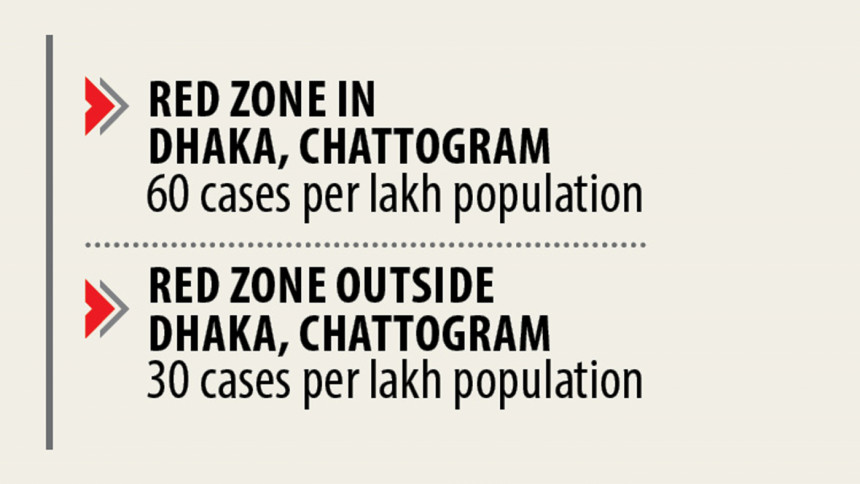Lockdown likely in smaller areas

The health directorate might soon announce the standard operating procedure of locking down small zones, ignoring the expert suggestions for sealing larger areas.
Any neighbourhood in Dhaka and Chattogram cities with 60 or more Covid-19 patients per one lakh people will be locked down and marked as "red zone", according to officials of Directorate General of Health Services (DGHS) making the plans.
Outside the two cities, the number of confirmed patients will have to be 30 or more for a neighbourhood to be marked red, they said.
This will go against the recommendations made by the National Technical Advisory Committee (NTAC) on Covid-19 of imposing lockdown on larger areas, experts said.
"The SOP is now awaiting approval of the director general [of the DGHS]. It will be published very soon," DGHS spokesperson Ayesha Akter told The Daily Star yesterday.
Experts said locking down these small red zones would be "futile" because the disease had spread "everywhere".
"The NTAC strongly recommends the authorities to impose complete lockdown in broader areas, considering... the risks across the country," the committee said in its meeting minutes on June 10.
NTAC member Prof Nazrul Islam said, "Based on such definition of a red-zone, it will need ten years to end all lockdowns."
The former vice chancellor of Bangabandhu Sheikh Mujib Medical University (BSMMU) added, "They could not implement any of our suggestions. Corruption and lax coordination are taking us into the gutter."
The government on June 1 decided to mark areas into three colour-coded zones, based on the number of infections and deaths.
But the decision has yet to be implemented.
Meanwhile, the number of infections and deaths from Covid-19 shows no sign of falling.
As an experiment, the government imposed lockdown in East Rajabazar area in the capital and in some parts of the country. Now the government has put Wari under lockdown.
MORE TESTS IS THE PREREQUISITE
According to the World Health Organization (WHO), Bangladesh will need 24,286 daily tests, considering its population.
However, there have been around 13,000 tests per day during the last two weeks.
The rate of daily new cases has risen in the last two weeks.
Positivity rate refers to the percentage of daily confirmed cases of Covid-19 against the total number of tests done.
Yesterday, the total number of confirmed cases surpassed 202,066.
On July 5, the positivity rate was 19.57 which rose to a record 25.23 percent on Wednesday.
"There is no alternative to increasing the daily number of tests. Otherwise, we will not be able to take the right programmes to control the outbreak," Dr Mushtuq Hussain, consultant of the Institute of Epidemiology, Disease Control and Research told The Daily Star recently.
According to a DGHS official involved in the laboratory coordination, the 79 Covid-19 testing laboratories have the capacity to test around 25,000 samples a day.
"But human resource shortage and people's unwillingness to be tested are the main reasons behind low number of tests," Prof Nasima Sultana, additional director general of the DGHS, told this newspaper recently.
EID RUSH MAY CAUSE TROUBLE
After many people rushed to their village homes in the last Eid, the cases rose.
Recently, the government has announced that public transport will not be suspended during the Eid holidays, though the Public Health Advisory Committee of DGHS suggested imposing curfew to restrict people's movement.
"There are many opinions on lockdown. However, the problem is that nothing is implemented rightly at all. We had lessons from last Eid. It is sure the upcoming Eid-ul-Azha will intensify the trouble," Dr Mushtuq Hussain told The Daily Star yesterday.


 For all latest news, follow The Daily Star's Google News channel.
For all latest news, follow The Daily Star's Google News channel. 



Comments